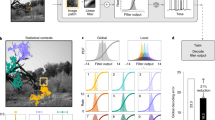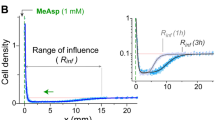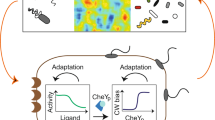Abstract
Adaptation is the essential process by which an organism becomes better suited to its environment. The benefits of adaptation are well documented, but the cost it incurs remains poorly understood. Here, by analysing a stochastic model of a minimum feedback network underlying many sensory adaptation systems, we show that adaptive processes are necessarily dissipative, and continuous energy consumption is required to stabilize the adapted state. Our study reveals a general relation among energy dissipation rate, adaptation speed and the maximum adaptation accuracy. This energy–speed–accuracy relation is tested in the Escherichia coli chemosensory system, which exhibits near-perfect chemoreceptor adaptation. We identify key requirements for the underlying biochemical network to achieve accurate adaptation with a given energy budget. Moreover, direct measurements confirm the prediction that adaptation slows down as cells gradually de-energize in a nutrient-poor medium without compromising adaptation accuracy. Our work provides a general framework to study cost-performance trade-offs for cellular regulatory functions and information processing.
This is a preview of subscription content, access via your institution
Access options
Subscribe to this journal
Receive 12 print issues and online access
$209.00 per year
only $17.42 per issue
Buy this article
- Purchase on Springer Link
- Instant access to full article PDF
Prices may be subject to local taxes which are calculated during checkout





Similar content being viewed by others
References
Niven, J. E. & Laughlin, S. B. Energy limitation as a selective pressure on the evolution of sensory systems. J. Exp. Biol. 211, 1792–1804 (2008).
Hazelbauer, G. L., Falke, J. J. & Parkinson, J. S. Bacterial chemoreceptors: high-performance signaling in networked arrays. Trends Biochem. Sci. 33, 9–19 (2008).
Hohmann, S. Osmotic stress signaling and osmoadaptation in yeasts. Am. Soc. Microbiol. 66, 300–372 (2002).
Menini, A. Calcium signalling and regulation in olfactory neurons. Curr. Opinion Neurobiol. 9, 419–426 (1999).
Nakatani, K., Tamura, T. & Yau, K. W. Light adaptation in retinal rods of the rabbit and two other nonprimate mammals. J. Gen. Physiol. 97, 413–435 (1991).
Ma, W. et al. Defining network topologies that can achieve biochemical adaptation. Cell 138, 760–773 (2009).
Sartori, P. & Tu, Y. Noise filtering strategies in adaptive biochemical signaling networks: Application to E. Coli chemotaxis. J. Stat. Phys. 142, 1206–1217 (2011).
Kampen Van, N. G. Stochastic Processes in Physics and Chemistry (North-Holland, 1981).
Tu, Y., Shimizu, T. S. & Berg, H. C. Modeling the chemotactic response ofE. Coli to time-varying stimuli. Proc. Natl Acad. Sci. USA 105, 14855–14860 (2008).
Lebowitz, J. L. & Spohn, H. A Gallavotti–Cohen-type symmetry in the large deviation funcional for stochastic dynmaics. J. Stat. Phys. 95, 333–365 (1999).
Parmeggiani, A., Julicher, F., Ajdari, A. & Prost, J. Energy transduction of isothermal ratchets: Generic aspects and specific examples close to and far from equilibrium. Phys. Rev. E 60, 2127–2140 (1999).
Seifert, U. Entropy production along a stochastic trajectory and an integral fluctuation theorem. Phys. Rev. Lett. 95, 040602 (2005).
Tome, T. Entropy production in nonequilibrium systems described by a Fokker–Planck equation. Brazilian J. Phys. 36, 1285–1289 (2006).
Qian, H. Phosphorylation energy hypothesis: Open chemical systems and their biological functions. Annu. Rev. Phys. Chem. 58, 113–142 (2007).
Barkai, N. & Leibler, S. Robustness in simple biochemical networks. Nature 387, 913–917 (1997).
Morton-Firth, C. J. & Bray, D. Predicting temporal fluctuations in an intracellular signalling pathway. J. Theor. Biol. 192, 117–128 (1998).
Yi, T. M. et al. Robust perfect adaptation in bacterial chemotaxis through integral feedback control. Proc. Natl Acad. Sci. USA 97, 4649–4653 (2000).
Mello, B. A. & Tu, Y. Perfect and near perfect adaptation in a model of bacterial chemotaxis. Biophys. J. 84, 2943–2956 (2003).
Endres, R. G. & Wingreen, N. S. Precise adaptation in bacterial chemotaxis through assistance neighborhoods. Proc. Natl Acad. Sci. USA 103, 13040–13044 (2006).
Shimizu, T. S., Tu, Y. & Berg, H. C. A modular gradient-sensing network for chemotaxis in Escherichia Coli revealed by responses to time-varying stimuli. Mol. Syst. Biol. 6, 382 (2010).
Berg, H. C. & Brown, D. A. Chemotaxis in Escherichia coli analysed by three-dimensional tracking. Nature 239, 500–504 (1972).
Ota, I. M. & Varshavsky, A. A yeast protein similar to bacterial two-component regulators. Science 262, 566–569 (1993).
Posas, F. et al. Yeast HOG1 MAP kinase cascade is regulated by a multistep phosphorelay mechanism in the SLN1-YPD1-SSK1 two-component’ osmosensor. Cell 86, 865–875 (1996).
Zufall, F., Shepherd, G. M. & Firestein, S. Inhibition of the olfactory cyclic nucleotide gated ion channel by intracellular calcium. Proc. Biol. Sci. 246, 225–230 (1991).
Matthews, H. R. & Reisert, J. Calcium, the two-faced messenger of olfactory transduction and adaptation. Curr. Opin. Neurobiol. 13, 469–475 (2003).
Walsh, C. Posttranslational Modification of Proteins: Expanding Nature’s Inventory (Roberts & Company Publishers, 2006).
Alon, U. et al. Robustness in bacterial chemotaxis. Nature 397, 168–171 (1999).
Detwiler, P. B. et al. Engineering aspects of enzymatic signal transdcusion: Photoreceptors in the retina. Biophys. J. 79, 2801–2817 (2000).
Sourjik, V. & Berg, H. C. Receptor sensitivity in bacterial chemotaxis. Proc. Natl Acad. Sci. USA 99, 123–127 (2002).
Lan, G. et al. Adapt locally and act globally: Strategy to maintain high chemoreceptor sensitivity in complex environments. Mol. Syst. Biol. 7, 475 (2011).
Landauer, R. Dissipation and noise immunity in computation and communication. Nature 335, 779–784 (1988).
Li, M. & Hazelbauer, G. L. Cellular stoichiometry of the components of the chemotaxis signaling complex. J. Bacteriol. 186, 3687–3694 (2004).
Berg, H. C. The rotary motor of bacterial flagella. Ann. Rev. Biochem. 72, 19–54 (2003).
Voet, D., Voet, J. G. & Pratt, C. W. Fundamentals of Biochemistry (Wiley, 1999).
Hopfield, J. J. Kinetics proofreading: a new mechanism for reducing errors in biosynthetic processes requiring high specificity. Proc. Natl Acad. Sci. USA 71, 4135–4139 (1974).
Savageau, M. A. & Freter, R. R. Energy cost of proofreading to increase fidelity of transfer ribonucleic acid aminoacylation. Biochemistry 18, 3486–3493 (1979).
Bennett, C. H. Dissipation-error tradeoff in proofreading. Biosystems 11, 85–91 (1979).
Qian, H. Reducing intrinsic biochemical noise in cells and its thermodynamic limit. J. Mol. Biol. 362, 387–392 (2006).
Schmidel, T. & Seifert, U. Efficiency of molecular motors at maximum power. Europhys. Lett. 83, 30005 (2008).
Koshland, D. E., Goldbeter, A. & Stock, J. B. Amplification and adaptation in regulatory and sensory systems. Science 217, 220–225 (1982).
Alon, U. An Introduction to Systems Biology: Design Principles of Biological Circuits (CRC Press, 2007).
Kashtan, N. & Alon, U. Spontaneous evolution of modularity and network motifs. Proc. Natl Acad. Sci. USA 102, 13883–13778 (2005).
Neumann, S. et al. Differences in signalling by directly and indirectly binding ligands in bacterial chemotaxis. EMBO J. 29, 3484–3495 (2010).
Acknowledgements
We thank J. Tersoff, T. Theis and K. Schwarz for comments. This work is partially supported by a National Institutes of Health (NIH) grant (R01GM081747 to Y.T.), a Deutsche Forschungsgemeinschaft (DFG) grant (SO 421/3-3 to V.S.), and a Cajamadrid fellowship to P.S.
Author information
Authors and Affiliations
Contributions
Y.T. initiated the work; G.L., P.S. and Y.T. carried out the theoretical calculations; S.N. and V.S. performed the experiments; G.L. did the data analysis; all authors wrote the paper.
Corresponding author
Ethics declarations
Competing interests
The authors declare no competing financial interests.
Supplementary information
Supplementary Information
Supplementary Information (PDF 478 kb)
Rights and permissions
About this article
Cite this article
Lan, G., Sartori, P., Neumann, S. et al. The energy–speed–accuracy trade-off in sensory adaptation. Nature Phys 8, 422–428 (2012). https://doi.org/10.1038/nphys2276
Received:
Accepted:
Published:
Issue Date:
DOI: https://doi.org/10.1038/nphys2276
This article is cited by
-
OxPhos defects cause hypermetabolism and reduce lifespan in cells and in patients with mitochondrial diseases
Communications Biology (2023)
-
The ecological roles of bacterial chemotaxis
Nature Reviews Microbiology (2022)
-
The optimal strategy balancing risk and speed predicts DNA damage checkpoint override times
Nature Physics (2022)
-
Epidermal growth factor receptor cascade prioritizes the maximization of signal transduction
Scientific Reports (2022)
-
Emergence of energy-avoiding and energy-seeking behaviors in nonequilibrium dissipative quantum systems
Communications Physics (2022)



